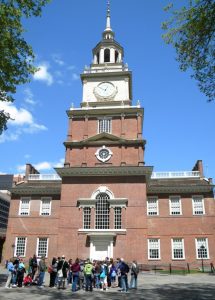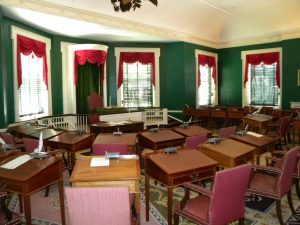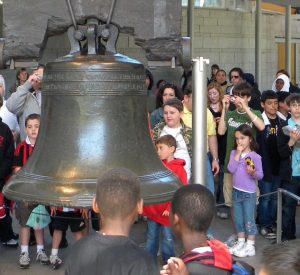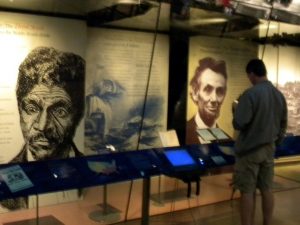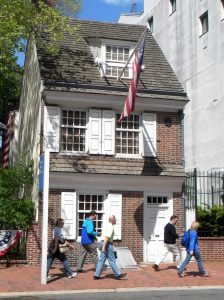Why is Philadelphia, Pennsylvania, important to Tennessee? Let us count the ways.
It was in Philadelphia that the the Declaration of Independence and Constitution were written, passed and signed.
Philadelphia was the home of Benjamin Franklin, a man so admired by early Tennesseans that they originally tried to name their state after him.
Philadelphia was the U.S. Capitol from 1790 until 1800. It was in Philadelphia that Congress voted to accept Tennessee as the 16th state and in Philadelphia that early Tennessee Congressmen such as William Blount and Andrew Jackson served.
So let’s visit Philadelphia.
Independence Hall
Our visit starts at Independence Hall — so named because this is where the Declaration of Independence and the Constitution were approved.
This building, which can be seen on the back of the $100 bill, was originally built in 1753 to be the home of the colonial government of Pennsylvania. When the colonial governments began to rebel against England, the First Continental Congress met in a nearby structure called Carpenters Hall. But when the Second Continental Congress met in 1775 and 1776, its delegates convened in this building.
Today we take for granted all the events involving the Declaration of Independence. But what the delegates did here was not necessarily expected and certainly not unanimous.
We took the guided tour twice and learned different things each time:
- July 2 (not July 4) was the actual day on which the delegates voted to declare independence from Great Britain (the official document was approved on the fourth).
- Although the official vote to declare independence from England was unanimous, there were delegates who disagreed with this stance, and who chose to stay away on the day the vote was taken.
- The 13 states originally chose 74 delegates to attend the Constitutional Convention. Of those, only 55 came; and of those 55, only 39 signed the document!
- Neither the Declaration of Independence nor the Constitution were signed on a single day, as painters depicted afterward. Some people who signed the Constitution may not have signed it until months later!
Congress Hall
After we walked out of Independence Hall, most of the crowd scattered. But, seeing another ranger about to do another tour, we joined along.
He took us into a building adjacent to Independence Hall which, he explained, is known as Congress Hall. From 1790 until 1800, Philadelphia served as the capital city of the United States. During this period, this brick structure was where the U.S. House of Representatives and Senate met.
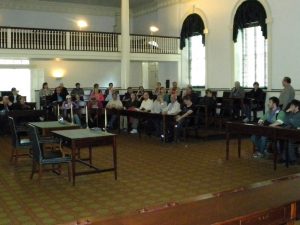 We, the visitors to Congress Hall, were allowed to walk right in and sit down where the U.S. House of Representatives met from 1790 until 1800. Talk about amazing!
We, the visitors to Congress Hall, were allowed to walk right in and sit down where the U.S. House of Representatives met from 1790 until 1800. Talk about amazing!
It was in this very room that early American Congressmen debated treaties with Great Britain and with Native American tribes. In this very room, the House voted on whether to accept Vermont, Kentucky and Tennessee as states. And a young U.S. Representative named Andrew Jackson made his first impression on Americans from other parts of the country in this very room.
And, in this very room, John Adams was sworn in to replace George Washington as president — the first transition from one president to the other in American history.
Upstairs you will find the Senate Chamber — which is smaller and more dignified than the House Chamber.
There was quite a bit of drama in this room in the 1790s, some of it related to Tennessee. In 1798, the House impeached and the Senate expelled Tennessee Senator William Blount for his involvement in a scheme involving possession of the Spanish-controlled territories of Louisiana and Florida. This incident was an early test of the federal government’s power and responsibilities.
The Liberty Bell
Across the street you will find one of the most famous symbols in American history. Today we refer to it as the Liberty Bell, but (like Independence Hall), it hasn’t always had that name.
This bell originally hung in the tour of the tower of the Pennsylvania State House building. It apparently rang at the first public reading of the Declaration of Independence, but did not become known as the “Liberty Bell” until abolitionists began calling it that in the 1830s. Incidentally, the word “liberty” appears on the bell because it appears in a Bible verse that is quoted on the bell, which says “proclaim liberty throughout all the land unto all the inhabitants thereof.”
The Liberty Bell is housed indoors along with a number of exhibits that talk about its history. You can walk right up to it and see it up close. You can also clearly see the two-foot-long crack in the bell. In case you are wondering, the bell originally cracked from overuse, probably in the 1830s.
The National Constitution Center
Nearby you will find the National Constitution Center, a new museum devoted to the U.S. Constitution. The center’s core exhibit, called We The People, tells the story of the Constitution, its legacy and its evolution.
The National Constitution Center is very high tech facility. You may find yourself overwhelmed by the sounds and sights of different exhibits, all competing for your attention in the same place (we did!). But if you remain focused, you will learn a lot here and find a lot of Tennessee history here.
We found, for instance, the story of Andrew Jackson’s disagreement with the U.S. Supreme Court over Indian removal (click here to read more about this). We found an exhibit devoted to the Scopes Trial (click here to read more about this).
The National Constitution Center also features Signers Hall, which features life-sized bronze sculptures of all 39 signers of the U.S. Constitution.
William Blount — then a delegate from North Carolina — greets you at the door. We from the Volunteer State know Blount as a Tennessee Senator and the state’s second governor.
Other things to see
Only a couple of blocks from Independence Hall and the Liberty Bell, you will find Christ Church Burial Ground.
Among the important people buried here is Benjamin Franklin. As you have read about elsewhere on the Tennessee History for Kids website, the state of Tennessee was very nearly named for this extraordinary man. However, this early attempt at statehood, known as the Lost State of Franklin, failed mainly because the leaders of North Carolina were opposed to it.
Franklin is only one of five signers of the Declaration of Independence buried here. One of the others is Joseph Hewes of North Carolina, who is buried in Christ Church Burial Ground because he died while serving as a member of the Continental Congress in 1779.
Since Tennessee was basically part of North Carolina at that time, Joseph Hewes would have been representing our part of the country at these very important proceedings. And in addition to being a signer of the Declaration of Independence, Hewes is considered to be the first Secretary of the Navy!
Within a few blocks you will also find the Betsy Ross Home.
It was here that seamstress Betsy Ross is said to have lived when George Washington and two other members of the Continental Congress asked her to sew an American flag (based on a design that many American troops were already using).
We learned a lot at the Betsy Ross home, including the fact that she was not famous in her time. In fact, Betsy Ross was only known by that name for four years; her maiden name was Elizabeth Griscom; her last name by her second husband was Ashburn; and her last name by her third husband was Claypoole!
If you walk in another direction you will find Washington Square.
 This open air park has a grim history. It was originally considered to be a burying ground for African Americans. Then, during the American Revolution as many as 2,000 soldiers were buried here, some in mass graves.
This open air park has a grim history. It was originally considered to be a burying ground for African Americans. Then, during the American Revolution as many as 2,000 soldiers were buried here, some in mass graves.

